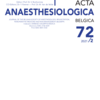Establishing changes in endotracheal cuff pressure with continuous monitoring in patients undergoing laparoscopic surgery in Trende- lenburg position
Endotracheal intubation ; endotracheal cuff pressure ; pressure monitoring ; mechanical ventilation ; general anesthesia
Published online: Mar 29 2022
Abstract
Background : After endotracheal intubation, the endotracheal cuff gets inflated to a sufficiently high pressure to prevent air leaking. Placing a patient in Trendelenburg position and establishing a pneumoperitoneum affects the endotracheal cuff pressure.
Objectives : Determine the impact of these factors on the endotracheal cuff pressure.
Design and setting : This prospective, observational study was conducted in the Catharina Hospital (Eindhoven, the Netherlands).
Methods : This study included adult patients undergoing laparoscopic surgery. A routine endotracheal tube was inserted, in which the cuff pressure was continuously monitored.
Main outcome measures : The outcome of interest was a change in endotracheal cuff pressure after establishment of a pneumoperitoneum and/ or placing a patient in a Trendelenburg position.
Results : 39 patients were included. Cuff pressures in- creased significantly from the moment of pneumo-peritoneum, placing a patient into a Trendelenburg position increased endotracheal cuff pressure and peak pressures even more. The highest endotracheal cuff pressure was 67 cm H2O, the highest registered peak pressure was 35 cm H2O.
Conclusion : Both endotracheal cuff pressure and peak pressure increased during laparoscopic surgical procedures with a pneumoperitoneum and the patient placed in Trendelenburg position. Measuring the endo-tracheal cuff pressure only after endotracheal intubation is insufficient and should be repeated during surgery on fixed moments.
